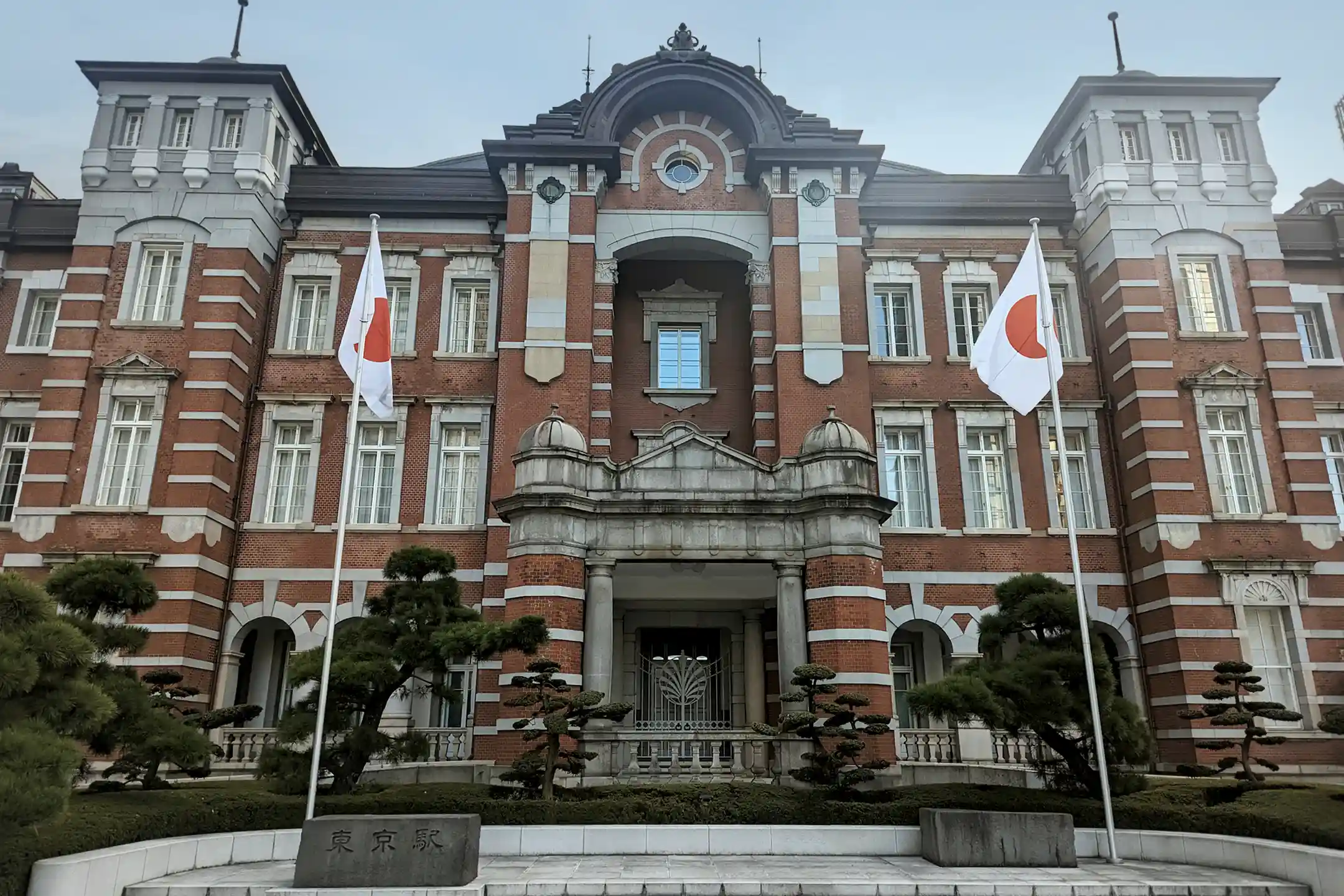Tokyo Station’s food scene is far more than a quick‑bite convenience for commuters on the go. While many Western rail terminals feel designed purely for transit, Japan’s stations double as lively social hubs—places where people meet, share culture, and, above all, eat.
Born in 1914, the red‑brick Marunouchi building was lovingly restored in 2012, blending contemporary amenities with its original grandeur. In the same way Japan has long absorbed foreign ideas and re‑crafted them into something uniquely local, the station marries Western construction methods with meticulous Japanese craftsmanship to create a one‑of‑a‑kind dining stage.
Its appeal reaches well beyond architecture: inside the concourse and throughout the surrounding district, a dazzling range of Tokyo Station food outlets awaits. From washoku classics to Western bistros, playful sweets to regional ekiben lunchboxes, the station is a vibrant crossroads of culinary culture—something rarely seen overseas.
This guide invites you to rediscover the station through food and to uncover the social forces that shaped this extraordinary place.
Tokyo Station Gourmet: Why All the Buzz?
A Unique Dining Atmosphere Born of Historic Architecture × Cutting‑Edge Design
Rooted in the 1914 red‑brick edifice and refreshed by a 2012 renovation, Tokyo Station faithfully revives its turn‑of‑the‑century elegance while embracing modern facilities. Architect Tatsuno Kingō borrowed Western techniques yet deftly infused Japanese artisanal detail. Today, the dome ceilings and reliefs hold official “Important Cultural Property” status (*1), underscoring that this is a national treasure, not merely a transport node.
Dining beneath these historic arches is a quintessentially Japanese delight seldom found in Europe or North America. Restaurants inside the Tokyo Station Hotel let you enjoy a meal beside the soaring dome, soaking up an ambience where past and present seamlessly merge. Nearby, the KITTE complex repurposes the former central post office, and similar retro‑modern spots dot the area. Walking the district, you’ll notice Japan’s hallmark approach: not simply preserving the old, but layering fresh design atop heritage to craft a streetscape with quiet gravitas.

Supreme Access, Infinite Choice
Serving more than 460,000 passengers a day (*2), Tokyo Station links every corner of Japan. Naturally, an astonishing variety of eateries flourishes inside its walls—washoku, yoshoku, Chinese, sweets, cafés—creating a “hundred‑flower blossom” of flavors. For visitors on tight schedules, sampling regional dishes without leaving the capital is a huge bonus.
The underground Tokyo Station Ichibangai complex, for instance, houses the curated Tokyo Ramen Street (*3) and character‑themed food courts. Thanks to Japan’s passion for faithful reproduction, regional specialties here capture local tastes more deeply than you might expect. Concentrating so many local cuisines in one spot may seem excessive abroad, yet it lets you sample the nation in miniature. The “food‑theme‑park” vibe is, in fact, a unique product of history and social structure.
Recommended Tokyo Station Food: Washoku, Western Cuisine & Sweets
Savoring Tradition at Long‑Established Washoku Restaurants
Tokyo Station lets you enjoy venerable flavors dating to the Meiji and Taishō eras. Tsukiji Sushisei, founded in 1889, serves authentic Edomae sushi right inside the concourse, always featuring seasonal seafood (*1). While “sushi” often conjures rolled creations in the West, classic nigiri rules here, maximizing the fish’s natural character. Watching the chef’s precise movements across the counter reveals Japan’s art of unseen care.
Within Kitchen Street you’ll also find tempura, soba, and wagyu rice bowls—everyday Japanese staples ready for a quick yet refined bite. Even if the sheer variety feels overwhelming, illustrated menus and station maps keep visitors at ease. High standards of omotenashi flourish—even in a bustling hub—reflecting centuries of service culture.

Refined Menus at Modern Cafés & Western Restaurants
Foreign‑friendly options abound: French, Italian, steakhouses, and more, often located in mall complexes that recall stylish European avenues. Yet chefs weave in Japan’s seasonal mindset, spotlighting local vegetables and seafood within global recipes.
Roughly forty eateries cluster inside Kitchen Street alone, ranging from casual grills to dessert‑centric cafés. Concerned about vegetarian choices? Offerings have grown steadily, with organic and vegan plates now common. Afternoon tea in the Tokyo Station Hotel’s bar lounge pairs European‑style elegance with discreet Japanese hospitality, prompting many guests to exclaim, “I never knew Tokyo could feel this modern!”

Sweet Retreats: Touring Cafés & Confectioners
A well‑chosen sweet turns a brief pause into a cultural interlude. From historic wagashi artisans to cutting‑edge patissiers, Tokyo Station is pure dessert heaven. At TORAYA TOKYO, gaze upon the red‑brick façade while savoring premium yōkan and seasonal confections (*2). The matcha‑wagashi duo delivers deep calm—even in minutes.
Prefer Western treats? Head to Daimaru’s sweets floor or Tokyo Okashi Land. The matcha parfait by Gion Tsujiri layers textures that keep your palate guessing (*3). Okashi Land also sells limited snacks from famous makers, letting you taste Japan’s playful “family snack” culture with minimal effort. Few places serve wagashi, French pastries, and quirky Japanese snacks side by side—Tokyo Station makes it delightfully easy.
Feed Your Curiosity with Ekiben & Limited‑Edition Bites
Ekiben History and Region‑Packed Lineups
Rail travel in Japan is inseparable from ekiben—the boxed meals first sold in the Meiji era. What began as simple rice balls at Utsunomiya Station (*1) grew into miniature “tour brochures” expressing local pride. Take masu no sushi: layers of trout and vinegared rice evoke Toyama’s landscape, while the cedar aroma released on opening the lid heightens a traveler’s mood (*2).
At Ekibenya Matsuri inside Tokyo Station, more than 150 signature ekiben from Hokkaidō to Kyūshū await daily (*3). Even before you reach a region, you can taste it in advance. Unlike the homemade‑lunch image abroad, buying ekiben within the station is part of the adventure. Each box invites you to imagine local scenery as you eat—the essence of Japanese food culture.
%20EkibenBento%20at%20Tokyo%20Station.webp?width=750&height=500&name=Warm%20Broiled%20Eel%20(Unagi%20Kabayaki)%20EkibenBento%20at%20Tokyo%20Station.webp)
How to Catch Seasonal & Collaboration Specials
New and limited ekiben appear constantly, tied to events or seasons. Long‑established Kiyōken releases themed sets—spring‑blossom motifs, Mother’s Day packages, and more. Crowd‑favorite Shūmai Fried Rice Bento often sells out by mid‑morning.
Character collaborations also pop up, featuring designs that turn heads. Beneath the playful surface lies Japan’s knack for marrying artisanal skill with novel ideas. Blending tradition and pop culture keeps ekiben evolving in ever more delightful forms.
A Plan to Enjoy Art & Food Together
Pair Nearby Museums & Galleries with Your Meal
Tokyo Station itself houses Tokyo Station Gallery inside the red‑brick walls—a favorite of commuters and travelers alike (*1). The vintage interior heightens contrasts with modern artworks, making the viewing experience all the more vivid.
A five‑minute walk from the south exit brings you to Mitsubishi Ichigokan Museum (*2), a faithfully reconstructed Meiji‑era office building. Exhibitions focus on late‑19th‑ to early‑20th‑century European art, showing how Japan absorbed Western culture during modernization. Though Western in form, subtle design touches reveal Japanese sensibility—a reminder that Japan re‑fashions imports rather than copying them outright.
Sample One‑Day Model Itinerary: Culture Meets Cuisine
Morning – Admire the dome ceilings and brick façade of the Marunouchi station building, then slip into Tokyo Station Gallery for art amid daily bustle.
Lunch – Pick up an ekiben or bite within GRANSTA. A beef bento from Tōhoku, for instance, may show how sweet‑savory simmering defines local beef culture. If the weather’s fine, enjoy a picnic on the refurbished plaza, framed by skyscrapers and heritage bricks for an unbeatable contrast (*3).
Afternoon – Wander to Mitsubishi Ichigokan Museum. Inside the brick halls, European paintings reveal echoes of Japan’s early‑modern cultural exchange. Wrap up with tea at Cafe 1894, where lofty ceilings and oak counters recreate a 19th‑century bank atmosphere with a Japanese calm.
Evening – Stroll Marunouchi Naka‑dōri to savor its mix of old and new before returning to the station. After such a day, you’ll see how Japan preserves tradition while welcoming fresh value.

Elevate Your Meal: Premium Services Around Tokyo Station
Sophisticated Spaces for Business & Pleasure
Beyond its business role, the area teems with world‑class restaurants and hotels, earning a reputation as a high‑end gourmet zone. In Japan, choosing quality spaces and cuisine is considered a sign of respect, so finding a fitting venue for celebrations or negotiations is rarely a struggle. For travelers, it’s the perfect chance to experience next‑level dining.

Luxury hotels and towers, many directly linked to the station, offer serene restaurants and cafés with sound‑proofed private rooms—ideal for smooth meetings with overseas guests. Reserve the same venue for a birthday dinner and you’ll forget you’re steps from Japan’s busiest terminal.
Why These Spots Shine for Special Occasions
Esterre at Palace Hotel Tokyo, led by a Michelin‑starred chef, is one standout. French techniques meet Japanese produce in dishes that have global gourmets talking (*1). Honoring local bounty echoes Japan’s historic “Wakon Yōsai” spirit—assimilating Western wisdom while preserving a Japanese soul.
Top restaurants here obsess over details: marble grandeur paired with warm wood hints at age‑old aesthetics, balancing Western formality with Japanese grace. Service embodies humility and sincerity, guiding international visitors with gentle care—hospitality rooted in social custom. Choices now include Italian, ethnic, vegetarian, and organic menus. After dining, art venues or theaters are a short stroll away, so the area suits every scene, from business lunches to milestone dinners. Access, variety, and elevated ambience together make Tokyo Station one of the capital’s premier dining districts.
Summary — An Extraordinary Moment Where Culture and Flavor Converge at Tokyo Station
Tokyo Station is no mere transit point; it is a nexus where Japan’s history, architecture, gastronomy, and art intersect. The classical brick beauty, eclectic Tokyo Ramen Street, and Ekibenya Matsuri all embody the creative tension of tradition and innovation. Nearby museums showcase dialogues between past and present, East and West, rewarding even a short visit with intellectual delight.
Fine‑dining venues offer dazzling Japan‑meets‑Europe collaborations and impeccable service, suitable for everything from business to anniversaries. Seasonal ekiben and limited goods reveal Japan’s talent for evolving while honoring its roots.
Explore Tokyo Station and you’ll find the journey’s highlight is not the train ride but what you taste and feel along the way. Even seasoned Japan travelers will uncover fresh surprises here. Immerse yourself in this realm where history crosses with modern life, and food fuses with culture—you’ll see stations, and Japan itself, through deeper, richer eyes.
Author Bio




.webp)
.webp)
